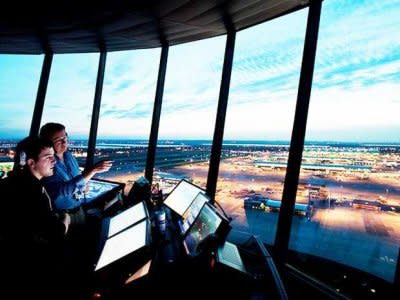Why Air Traffic Controllers Face A Staffing Crisis Every 25 Years

Beginning this week — as part of the government's mandatory budget cuts — nearly 15,000 air traffic controllers, along with 47,000 total FAA employees — are required to takeone to two furlough days every two weeks until September.
This shortage in staff is expected to delay flights in airports across the country.
But aside from budget cuts, a shortage of air traffic controllers will be a burden the FAA will face every 25 years. Here's why:
On August 3, 1981, 7,000 flights were cancelled when 13,000 air traffic controllers walked out on their jobs to strike against unsuccessful contract negotiations between the Professional Air Traffic Controllers Organization and the FAA.
Two days later, then President Ronald Reagan fired almost all the strikers, prohibited them from ever being rehired by the FAA and created a cycle of staffing shortages.
“They operated that system on nothing more than a political agenda and we’re still paying the price now,” Gregory McGuirk, an associate professor at Embry Riddle Aeronautical University and a former air traffic controller, told us. “What it did was set up a cycle with one signature."
The “cycle” – a direct result stemming from Reagan’s dismissal decision – will occur every 25 years when the majority of air traffic controllers reach the mandatory retirement age of 56. The cycle will continue happening because two current FAA hiring requirements are that controllers have to “be no older than age 30” and retire by the age of 56.
Currently, the FAA projects a total loss of 14,657 controllers over the next ten years and will need to fill 11,000 positions by the fiscal year 2019. Since 2006, the FAA has been hiring approximately 800 air traffic controllers every year to fill those soon-to-be vacant positions.
"When [the strike] happened, everyone thought it would take six months to recover," McGuirk said. "In fact it took 11 years to stabilize the system.”
After the strike, controllers who still had jobs worked stringent schedules of mandatory six-day shifts and very often 10-hour days, said McGuirk, who spent nearly 18 years as an air traffic controller and another nearly 18 years in air traffic management.
“I was almost envious of the ones who got fired," he said.
The National Air Traffic Controllers Association has repeatedly warned the FAA of demanding work schedules and exhausted air traffic controllers have been the suspects of plane crash investigations conducted by the National Transportation Safety Board.
At the beginning of 2011, the FAA faced significant public distrust as several napping incidents involving air traffic controllers during their shifts became known through media attention and the NATCA recommended that the FAA reconsider staffing levels.
In some countries, such as Germany, France and Japan, air traffic controllers are encouraged to take naps to combat fatigue. In other safety sensitive positions – firefighters, doctors and ambulance personnel – beds and resting areas are provided during shift breaks in order to fight exhaustion.
In 2009, approximately 80% of general aviation fatal accidents were directly related to human errors.
Upon the completion of their technical training at the FAA Academy in Oklahoma City, Okla., controllers are either placed in highly active airports, which requires at least two years of additional training, or less hectic airports, which only requires an additional six months of training. But whether an air traffic controller is assigned to Hartsfield-Jackson Atlanta International or Oakland International is not based on scoring or aptitude.
“One would think that people who score higher would go to the more complex centers but that’s not typically the case,” McGuirk said. “I don’t think there is any reason behind the decisions and that troubles me.”
So why don't some air traffic controllers just quit? If they did, then new controllers could be hired and perhaps this staffing crisis won't continue happening. Well, some of them do quit from time to time, but not enough of them to stop the staffing crisis.
First, it takes a few years to be trained as a controller and it takes a certain kind of person to want to get into this type of job — the hours are long and you have other people's lives in your hands at all times. Furthermore, despite staffing issues, becoming an ATC right now is highly competitive, so after all the training and hard work to get the job, most people who decide to become an ATC don't just leave their jobs. They're also among t he highest-paid federal workers in the U.S., earning an average of $136,000 annually.
The current required furloughs are expected to affect as many as 6,700 flights nationwide and cut around $200 million in spending. According to the FAA web site, the worst case s cenario expected would result in 3.5 hour delays.
More From Business Insider

